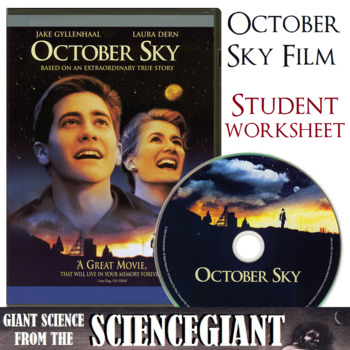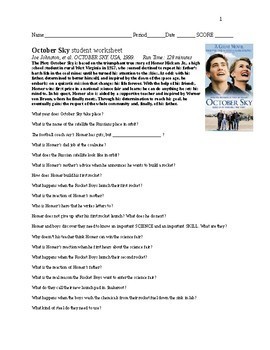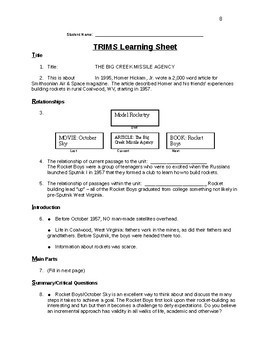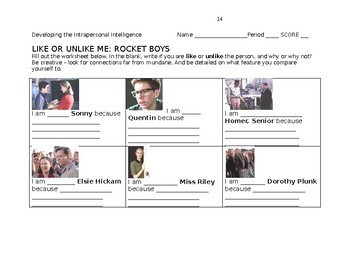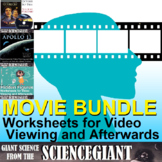October Sky video viewing and after activities
- Word Document File
What educators are saying
Also included in
- Teachers use the Strategic Instruction Model (SIM) Concept Enhancement Routines to transform abstract main ideas and key topics into a concrete representation that helps students think about and talk about the key topic and essential related information. SIM is about promoting effective teaching andPrice $49.70Original Price $71.00Save $21.30
- These resources can be used during a unit ( for example, on rocketry and the Space Race), as an emergency substitute activity at any point throughout the school year, or after the completion of state standardized testing (I've done all three). It consists of separate worksheets:Questions that studenPrice $3.85Original Price $5.50Save $1.65
Description
The film October Sky (1999) is adapted from "Big Creek Missile Agency" and Rocket Boys: A Memoir, by Homer Hickam Jr. They tell the heart-touching story of growing up in a rural West Virginia mining town in the late 1950’s, and boyhood friends’ pursuit of amateur rocketry. History changed on October 4, 1957, when the Soviet Union successfully launched Sputnik, the world's first artificial satellite. That launch ushered in the start of the space age while the coal industrial declined and the teenager's town crumbled.
This product can be used during a unit on rocketry and the Space Race as an emergency substitute activity at any point throughout the school year, or after the completion of state standardized testing (I've done all three). It consists of three separate worksheets:
- Questions that Ss should answer while watching the October Sky. Questions are open response and focus on the film's plot. They are answered in chronological order of the film's plot for easy completion by students, and encourage student attentiveness.
- Like/Unlike worksheet for after viewing where Ss can compare and contrast themselves to the characters in the film, and write short answers which can detail their developing intra-personal Intelligence.
- Survey Routine on the reading the article "Big Creek Missile Agency". Teacher use of the Survey Routine helps Ss prepare for reading assignments by making Ss aware of the main ideas associated with the passage to help them focus on the most important information as they read. The routine helps Ss analyze the structure and key content of a passage by discussing its title, predicting content, identifying its relationship to other passages in the unit of study, naming its main parts, identifying key information, and paraphrasing a summary of the passage. In studies, students answered an average of 10 percent to 15 percent more of their test questions correctly when the Survey Routine was used that when it was not. These results were seen with all students, including those with learning disabilities and other low-achieving students as well as average- and high-achieving students.
This Strategic Instruction was classroom tested to help Ss with the following Florida Next Generation Sunshine State Standard Benchmarks: Students Will Be Able To (SWBAT/I Can)
- SC.8.N.4.1 Explain that science is one of the processes that can be used to inform decision making at the community, state, national, and international levels.
- SC.8.N.4.2 Explain how political, social, and economic concerns can affect science, and vice versa.
- SC.8.E.5.12 Summarize the effects of space exploration on the economy and culture of Florida.
- SC.912.N.2.5 Describe instances in which scientists' varied backgrounds, talents, interests, and goals influence the inferences and thus the explanations that they make about observations of natural phenomena and describe that competing interpretations (explanations) of scientists are a strength of science as they are a source of new, testable ideas that have the potential to add new evidence to support one or another of the explanations.
- SC.912.N.4.1 Explain how scientific knowledge and reasoning provide an empirically-based perspective to inform society's decision making.
- SC.912.N.4.2 Weigh the merits of alternative strategies for solving a specific societal problem by comparing a number of different costs and benefits, such as human, economic, and environmental.
- SC.912.E.5.7 Relate the history of and explain the justification for future space exploration and continuing technology development.
- SC.912.E.5.9 Analyze the broad effects of space exploration on the economy and culture of Florida.
Related Resource
- Apollo 13 video viewing and after activities
- Hidden Figures video viewing and after activities
- Question Exploration and Lab: How Do Rockets Work?
- Question Exploration: How Are Latitude and Longitude Use for Landing Sites?
- Nibble Like a RABBit: Edible Model of a Moon to Mars Tool
- Mission Patch Plan: Design and Meaning for Moon to Mars
- If You Decide To Go To The Moon - ELA Enrichment Activities and Printables
#StayGiant and stay up on my new resources and STEM news. Look for the green ★ star near the top of any page within my store and click "FOLLOW". Or follow @TheScienceGiant Twitter. Stand on The Shoulders of Giants, and together we'll see further, inspire students, and enlighten inquisitive minds!

